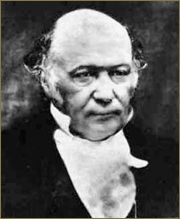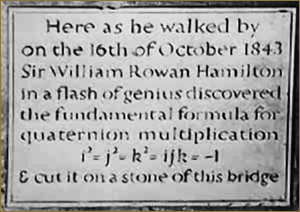Quaternions arose historically from Sir William Rowan Hamilton’s attempts in the midnineteenth century to generalize complex numbers in some way that would be applicable to three-dimensional (3D) space. Because complex numbers (which we will discuss in detail later) have two parts, one part that is an ordinary real number and one part that is “imaginary,” Hamilton first conjectured that he needed one additional “imaginary” component. He struggled for years attempting to make sense of an unsuccessful algebraic system containing one real and two “imaginary” parts. In 1843, at the age of 38, Hamilton (see Figure 1.1) had a brilliant stroke of imagination, and invented in a single instant the idea of a three-part “imaginary” system that became the quaternion algebra. According to Hamilton, he was walking with his wife in Dublin on his way to a meeting of the Royal Irish Academy when the thought struck him. Concerning that moment, he later wrote to his son Archibald:

(History of Mathematics web pages of the University of St. Andrews, Scotland.)
Figure 1.1. Sir William Rowan Hamilton, 4 August 1805–2 September 1865.
On the 16th day of [October]—which happened to be a Monday, and a Council day of the Royal Irish Academy—I was walking in to attend and preside, and your mother was walking with me, along the Royal Canal, to which she had perhaps driven; and although she talked with me now and then, yet an under-current of thought was going on in my mind, which gave at last a result, whereof it is not too much to say that I felt at once the importance. An electric circuit seemed to close; and a spark flashed forth, the herald (as I foresaw, immediately) of many long years to come of definitely directed thought and work, by myself if spared, and at all events on the part of others, if I should even be allowed to live long enough distinctly to communicate the discovery. Nor could I resist the impulse—unphilosophical as it may have been—to cut with a knife on a stone of Brougham Bridge, as we passed it, the fundamental formula with the symbols, i, j, k; namely,
i2 = j2 = k2 = ijk= –1
which contains the Solution of the Problem. . .
A curiosity is that there is no “Brougham Bridge” in Dublin. Hamilton apparently misspelled the name “Broome,” which is indeed the name of the bridge on which he carved his equations, since the two spellings would have been pronounced the same.
We can see that Hamilton was so overwhelmed by his discovery that he feared he might collapse and die before he had a chance to tell anyone, and thus, for safety, carved the equations into the nearest wall, the side of a bridge arching over the canal along which he was walking! Although Hamilton’s own carving soon disappeared with the weather, a plaque (Figure 1.2) was later placed on the very spot, and commemorates the event to this day.

(Photograph courtesy University of Dublin.)
Figure 1.2. The plaque on Broome Bridge in Dublin, Ireland, commemorating the legendary location where Hamilton conceived of the idea of quaternions. In fact, Hamilton and his wife were walking on the banks of the canal beneath the bridge, and the plaque is set in a wall there.
A feature of quaternions that we will use throughout this book is that they are closely related to 3D rotations, a fact apparent to Hamilton almost immediately but first published by Hamilton’s contemporary Arthur Cayley in 1845 [28]. Hamilton’s quaternion multiplication rule, which contains three subrules identical to ordinary complex multiplication, expresses a deep connection between unit-length four-vectors and rotations in three Euclidean dimensions. Curiously, the rule could in principle have been discovered directly by seeking such a connection, since quaternion-like relations appear buried in rotation-related formulas that predate the discovery of quaternions by Hamilton. Rodrigues appears to actually have been the first, in 1840 [142], to write down an equivalent version of the equations that Hamilton scratched on “Brougham” Bridge in 1843 [5,17,112]. The appearance of three copies of the complex multiplication rule and the involvement of three Euclidean dimensions is not accidental. Complex multiplication faithfully represents the two-dimensional (2D) rotation transformation, and each complex multiplication subrule in the quaternion rule will be seen to correspond to a rotation mixing two of the three possible orthogonal 3D axes.
Hamilton proceeded to develop the features of quaternions in depth over the next decade, and published his classic book Lectures on Quaternions [64] exactly ten years later in 1853. The still more extensive Elements of Quaternions [65] was not published until 1866, shortly after Hamilton’s death in 1865. The banner of quaternions was then picked up by Peter Tait, who had diplomatically awaited Hamilton’s passing before publishing his own, perhaps more readable, opus, Elementary Treatise on Quaternions, [160] in 1867; Tait followed the Treatise with Introduction to Quaternions in 1873 [161], and produced a major revision of the Treatise in 1890 [162]. From there, the story continues in many directions that we shall not pursue here (see, for example, Altmann [4,5], Crowe [35], or van der Waerden [164]).
One of the fascinating questions that occurred to several people shortly after they learned of Hamilton’s discovery was this: “If quaternions generalize complex numbers, can quaternions themselves be further generalized?” Although the technical answer to this question is complex, it was quickly found that, given certain compelling mathematical conditions, there is exactly one further generalization, the octonions.
The story of octonions is nearly as interesting as that of quaternions. Soon after Hamilton discovered quaternions, he sent a letter describing them to his friend John T. Graves. Graves replied on 26 October, complimenting Hamilton on the boldness of the idea, but adding “There is still something in the system which gravels me. I have not yet any clear views as to the extent to which we are at liberty arbitrarily to create imaginaries, and to endow them with supernatural properties.” He also asked: “If with your alchemy you can make three pounds of gold, why should you stop there?” [9].
On 26 December 1843, Graves wrote to Hamilton to tell him that he had successfully generalized quaternions to the “octaves,” an 8-dimensional (8D) algebra, with which he was able to prove that the product of two sums of eight perfect squares is another sum of eight perfect squares. Unfortunately for Graves, Hamilton put off assisting him in publishing his results and octonions were discovered independently and published in 1845 by Arthur Cayley [29]. Despite the fact that both Graves and Hamilton published notes claiming Graves’ priority over Cayley, the octonions were thereafter known widely as “Cayley numbers,” and Graves’ contribution is often overlooked. There are in fact several ways in which we can look for generalizations of quaternions. These are typically very advanced topics, but we have provided a brief treatment for the interested reader in Part III.
Since the intense work on quaternions that occurred in the 19th century, many things have happened. One is that, although Hamilton lobbied tirelessly to get quaternions accepted as the standard notation for 3D vector operations such as the dot product and the cross product (see Chapter 3 or Appendix A), the notation was always perceived as awkward, and thus the alternative tensor notation set forward by Gibbs became the standard [35]. Even in this book, we will universally use Gibbs’ notation x = (x, y, z) to express a 3D vector and to help “explain” the inner workings of quaternions, rather than the other way around. When the quantum mechanics of the electron was developed in the early 20th century, it became clear that quaternions were related to recently developed mathematical objects called spinors, and that electrons were related to both. Yet again, a quaternion-based notation was possible, but was discarded in favor of an alternate notation; the quaternion-equivalent notation that is standard in physics applications is based on 2 × 2 matrices, known as the Pauli matrices.
Both the physical theory of rotating elementary particles and essential elements of the mathematics of group theory incorporate quaternions, but the intense interest of Hamilton’s era dimmed due to more transparent notational devices (an advantage never to be underestimated) and a lack of important practical applications. However, the theory of 3D rotations had one more trump card waiting in the wings of technology: the need for comprehensive methods of representing orientation frames and interpolating between them in the newly developed field of 3D computer graphics and animation. We will now, therefore, conclude our short history by devoting some space to the remarkable story of the revival of quaternions and their adaptation to the needs of the computer modeling and animation community.
Although the advantages of the quaternion forms for the basic equations of attitude control (clearly present in Cayley [28], Hamilton [64], and especially Tait [160]) had been noticed and exploited by the aeronautics and astronautics community [169,98,103], the technology did not penetrate the computer animation community until the landmark Siggraph 1985 paper of Ken Shoemake [149]. The importance of Shoemake’s paper is that it took the concept of the orientation frame for moving 3D objects and cameras, which require precise orientation specification, exposed the deficiencies of the then-standard Euler-angle methods, and introduced quaternions to animators as a solution. This stimulated a wide variety of investigations and applications (e.g., [4,139,104,115]), ultimately creating a general awareness of quaternion exploitation as practiced by many different scientific communities, and potentially unifying the approaches so that perhaps the “quaternion wheel” will no longer be reinvented unnecessarily.
The primary tool introduced in Shoemake’s original paper was the interpolation formula for a great circle connecting two points on an arbitrary-dimensional sphere. By analogy to the acronym “LERP” that might be used for ordinary linear interpolation, Shoemake coined the term “SLERP” for “spherical linear interpolation,” a terminology that remains in common usage. Curiously, Shoemake himself did not present a derivation of the SLERP formula in his original paper, although there are several standard approaches, such as the Gram–Schmidt method, that we will present in later chapters.
Given the SLERP, the analogy to standard iterative procedures for constructing arbitrary-degree Euclidean splines from linear interpolation immediately suggests methods for constructing spherical splines. Spherical arcs from the SLERP can, if one analyzes the anchor points judiciously, be transformed to provide close analogs of the anchor-point and tangent-direction properties of the conventional families of Euclidean splines. It is reasonably straightforward to develop uniform quaternion spline families in an elegant practical form, and we will discuss quaternion splines thoroughly.
The computer graphics and modeling community now has general familiarity with quaternions and their uses, but we should note that there are still unresolved issues and controversies regarding the necessity or advantages of quaternion orientation representations. A number of industry-standard animation systems continue to omit quaternions entirely, requiring separate x-axis, y-axis, and z-axis interpolations for character and camera orientation control, and the author has more than once asked an animation team member of a graphics-effects-laden Hollywood movie whether quaternions were used to control orientations in their software and received a dismissive negative answer. The explanation is that good tools, or extremely skilled use of poor tools, can still produce good results, and that quaternion curve methods can easily suffer from their own anomalies unless skillfully applied. Without good tools and sophisticated designers, quaternion methods can produce results that are as poor as any other naively applied orientation spline method and that may show no clear superiority over a classic Euler-angle approach. Increasingly sophisticated quaternion interpolation tools, as well as awareness of their advantages, are necessary to generate an environment in which quaternions realize their potential for the representation and manipulation of orientation states. Creating and facilitating this awareness is one of the purposes of this book.
